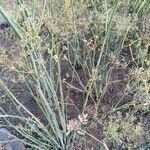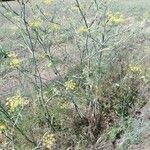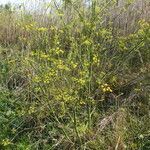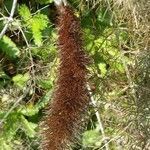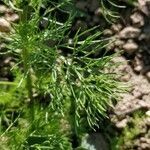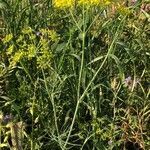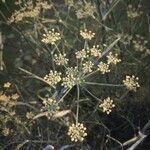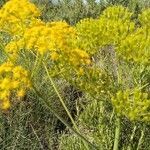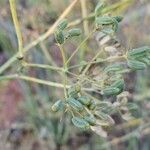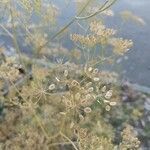Perennial, entirely glabrous. Stems erect, to 2 m. Sheaths 4-12 cm in the lower leaves, shorter upwards, apex with cucullate-connate auricles; lamina usually 3-4-pinnate, segments filiform. Compound umbels terminal to the stems and the branches; peduncles 5-16 cm; rays 30-70, 5-7 cm; pedicels 5-30, ½-1 cm; involucres and involucels none. Calyx teeth none. Petals yellow, strongly curved inward. Mericarps nearly 8 by 2 mm, ribs flliformous, nearly equal, not at all winged.
A green leafy perennial herb. It can be 2 m high and 45 cm wide. The leaves are very fine. They have a feathery appearance. The stems are ribbed and at the bottom of the stalks there is a broad green section. When the leaves are crushed, they smell like aniseed. The flower at the top is a group of small yellow flowers. The seeds are oval and ribbed and about 5 mm long. Ripe fruit are wingless which distinguishes it from dill. There are several named cultivated varieties.
Stout, aromatic, erect perennial. Stems ± solid, striate, polished, up to c. 2 m high. Basal lvs 3-5-pinnate, petiolate; ultimate segments filiform, acuminate, 3-50 mm long, not all in one plane; stem lvs similar to basal; petiole extended along whole length into a thin closely-ribbed sheath. Umbels 2-5 cm diam.; rays 4-25, usually slightly incurved at fruiting. Fls numerous, yellow, 1-2 mm diam. Fr. dark brown, 3-6 mm long, tasting of liquorice; ribs pale brown.
Robust, glabrous, slightly glaucous, perennial herb, 1-3 m high; stem erect, ribbed. Leaves 3-or 4-pinnate, with narrowly linear to narrowly acicular segments, base sheathing. Flowers in many-rayed, terminal or lateral umbels; involucre absent. Calyx obsolete. Petals inflexed at apex, bright yellow. Stylopodium short, broadly conical. Flowering time Nov.-Mar. Fruit narrowly ovoid, with prominent ridges at maturity; glabrous; vittae 6, large.
Plants 0.4–2 m. Lower petioles 5–15 cm; blade broadly triangular in outline, 4–30 × 5–40 cm, 4–5-pinnatisect; ultimate segments linear, 1–6 × ca. 0.1 mm. Umbels 5–9 cm across; peduncles 2–25 cm; rays 6–29(–40), unequal, 1.5–10 cm; umbellules 14–39-flowered; pedicels thin, 2–10 mm, unequal. Fruit 4–6(–10) × 1.5–2.2(–2.5) mm. Fl. May–Jun, fr. Jul–Sep.
Short-lived perennial, stout, 1–2 m, glabrous and glaucous; lf-segments mostly 1–4(–5) cm, well under 1 mm wide; rays 10–40, unequal, mostly 2–8 cm at maturity; fr 3.5–4 mm, the ribs acute; 2n=22. Native of the Mediterranean region, now found throughout much of the U.S., especially southward, and elsewhere in warm regions.
Leaves with well-developed sheathing bases, up to 5 cm. long but frequently much shorter, 3–4-pinnate with finely-divided ultimate segments which are narrowly linear to capillary, becoming reduced upwards towards the inflorescence and finally occurring only as sheathing bases with 0–few linear lobes.
Fruit 4–8 mm. long, narrowly ovoid at maturity, very distinctly glaucous-grey especially when immature; stylopodium rather low. Mericarps with ribs that are obvious at maturity, but inconspicuous in young fruit.
Umbels terminal and lateral, rays (4)9–30, 1–11 cm. long, relatively robust and somewhat glaucous. Partial umbels with up to 12 flowers on pedicels 5–10 mm. long; bracts and bracteoles 0 (rarely few).
Perennial herb, up to 2 m high. Leaves 3-or 4-pinnate with finely divided ultimate segments which are narrowly linear to capillary. Fruit distinctly glaucous grey. Flowers bright yellow.
Robust, glabrous, somewhat glaucous perennial herb up to 2 m.
Stems rigid when mature and with many fine distinct ribs.
Calyx teeth obsolete; petals bright yellow.
